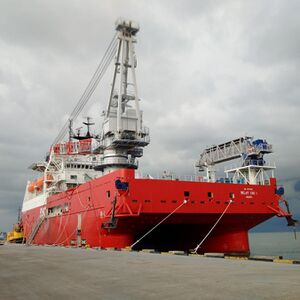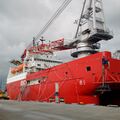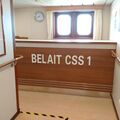Engineering:Belait CSS-1
 Belait CSS-1 docked in Muara Port on 22 May 2015.
| |
| History | |
|---|---|
| Name: | Belait CSS-1 |
| Owner: | Belait Shipping |
| Port of registry: | Muara, Brunei |
| Builder: | Mawei Shipbuilding Co., China |
| Cost: | 526 million yuan ($80 million) |
| Acquired: | 25 February 2015 |
| Commissioned: | 25 February 2015 |
| Identification: |
|
| Status: | Active |
| General characteristics | |
| Type: | Accommodation platform |
| Displacement: | 3,800 tons |
| Length: | 84 m (275 ft 7 in) |
| Draught: | 10.5 m (34 ft 5 in) |
| Depth: | 20.5 m (67 ft 3 in) |
| Propulsion: | 6 x 2800KW generators |
| Speed: | 9.1 knots (16.9 km/h; 10.5 mph) maximum |
| Boats & landing craft carried: | 4 x Life boats |
| Aviation facilities: | Helicopter landing platform |
Belait CSS-1 is a well intervention vessel and Accommodation platform owned by Belait Shipping. She can provide places for accommodations, and perform maintenance, rescue, and hoist activities.[1] She has a sister ship named Belait CSS-2, commissioned four years after CSS-1.
Construction and career
Construction of Belait CSS-1 was commissioned by Belait CSS Sendirian Berhad, an SPV Company registered in Brunei Darussalam. Belait CSS-1 was primarily built as a well-intervention vessel to support production of oil in Brunei. She cost about 526 million yuan ($80 million),[2] was built in Fujian, China and registered in Muara, Brunei.
Belait CSS-1 was undocked from the shipyard on 7 December 2013 and delivered to Brunei on 25 February 2015.[3][4] She regularly travels to the Champion Field, which is a complex oil and gas field, situated 40 kilometres north-northwest of Bandar Seri Begawan, in water depths of 10 to 45 metres. She usually docks in Muara Port, Brunei after every return voyages.
Equipments
The CSS is a multi-function well-intervention, supply, and light construction vessel, with accommodation for workers. It is equipped with a 150 T lattice boom crane, a telescopic heave compensated gangway, a moonpool, a 12.8 T rated helideck, DP-2 rating, and accommodation up to 200 people.[5]
She was designed by Vard Marine. The CSS is a cost-effective, stable platform with most of the capabilities of much larger vessels at a far lower cost. In addition, the design can be built at shipyards around the world.[6]
Gallery
- Belait CSS-1 Gallery
References
- ↑ "BELAIT CSS 1 (Platform) Registered in Brunei - Vessel details, Current position and Voyage information - IMO 9676785, MMSI 508111180, Call Sign V8V3145". https://www.marinetraffic.com/en/ais/details/ships/shipid:698322/mmsi:508111180/imo:9676785/vessel:BELAIT_CSS_1.
- ↑ "Belait Shipping & QESS - shipping Brunei - Awang Haji Ali" (in en-US). http://www.the-businessreport.com/article/belaitqess-partner-with-china-shipbuilders/.
- ↑ "The delivery for the fifth multi-purpose PSV with twin-hull semisubmersible platform - Eshiptrading.com". https://www.eshiptrading.com/News/View/14573.
- ↑ "China: Construction of Belait CSS 1 Nears Completion" (in en-US). 2013-12-12. https://www.offshore-energy.biz/china-construction-of-belait-css-1-nears-completion/.
- ↑ "Belait CSS 1 Undocks from Fujian Mawei Shipyard" (in en-US). 2013-12-12. https://www.offshore-energy.biz/belait-css-1-undocks-from-fujian-mawei-shipyard/.
- ↑ "Compact Semi-Submersible (CSS) Designs - Vard Marine Inc." (in en-US). https://vardmarine.com/vessels/css-designs/.
 |



